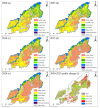Change of Rice Paddy and Its Impact on Human Well-Being from the Perspective of Land Surface Temperature in the Northeastern Sanjiang Plain of China
- PMID: 35955046
- PMCID: PMC9368393
- DOI: 10.3390/ijerph19159690
Change of Rice Paddy and Its Impact on Human Well-Being from the Perspective of Land Surface Temperature in the Northeastern Sanjiang Plain of China
Abstract
Large-scale and high-speed paddy land expansion has appeared in Northeast China since the 21st century, causing the change in land surface temperature. The lack of continuous investigation limits the exploration of discoveries in this region. To address this limitation, a collaborative approach that combined human-computer interaction technology, gravity center model and spatial analysis was established. It provided some new findings in spatiotemporal evolution, migration trajectory and surface cooling effect of the paddy field in Northeastern Sanjiang Plain, a center of paddy field planting in China. The results show that: (1) A sustained paddy expansion was monitored, with a total area ranging from 2564.58 km2 to 11430.94 km2, along with a rate of growth of 345.72% from 2000 to 2020. Correspondingly, its reclamation rate changed to 47.53% from 10.66%, showing the improved planting level of the paddy field. (2) Gravity center of paddy field continued to be revealed northward with a 5-year interval from 2000 to 2020. Migration distance of the straight line reached 23.94 km2, with the direction offset of 27.20° from east to north. (3) Throughout the growing season of crops, the land surface temperature of paddy field was 27.73°, 29.38°, 27.01°, 25.62° and 22.97° from May to October; and the cooling temperature effect of paddy field was investigated, with the reduced values of 0.61°, 0.79° and 1.10° in the low-, medium- and high-paddy field density regions from 2000 to 2020, respectively. Overall, these new findings in the cold temperate zone, high latitude region of the Northern Hemisphere, provided the reference for the investigation of paddy field monitoring and its environmental effects in China and other regions.
Keywords: Sanjiang Plain of China; land surface temperature; land use change; paddy field.
Conflict of interest statement
The authors declare no conflict of interest.
Figures







References
-
- Yan F., Yu L., Yang C., Zhang S. Paddy field expansion and aggregation since the mid-1950s in a cold region and its possible causes. Remote Sens. 2018;10:384. doi: 10.3390/rs10030384. - DOI
-
- Firdaus R.R., Leong Tan M., Rahmat S.R., Senevi Gunaratne M. Paddy, rice and food security in Malaysia: A review of climate change impacts. Cogent Soc. Sci. 2020;6:1818373. doi: 10.1080/23311886.2020.1818373. - DOI
-
- Yamamura K., Yokozawa M., Nishimori M., Ueda Y., Yokosuka T. How to analyze long-term insect population dynamics under climate change: 50-year data of three insect pests in paddy fields. Popul. Ecol. 2006;48:31–48. doi: 10.1007/s10144-005-0239-7. - DOI
-
- Zhuang Y., Liu H., Zhang L., Li S. Research perspectives on paddy field systems: Ecological functions and environmental impacts. Int. J. Agric. Sustain. 2020;18:505–520. doi: 10.1080/14735903.2020.1793652. - DOI
Publication types
MeSH terms
LinkOut - more resources
Full Text Sources

